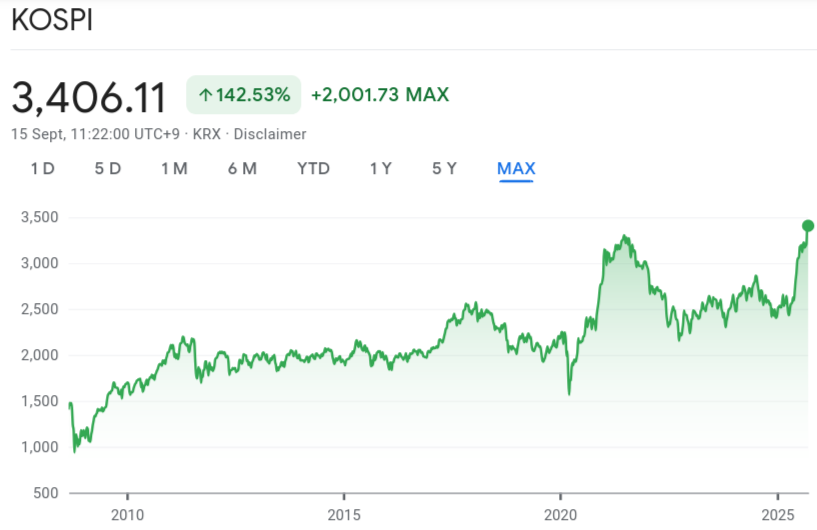
South Korean Stocks Hit Record High After Government Drops Capital Gains Tax Increase Plans
Korean Markets Surge to Record Heights as Government Retreats from Tax Tightening
Policy reversal on capital gains threshold sparks tenth consecutive trading session of gains, propelling KOSPI beyond 3,400 points for first time
South Korean markets carved out new territory on Monday as government officials definitively abandoned controversial plans to tighten capital gains taxation on stock investments, sending the benchmark KOSPI index to an unprecedented 3,408.71 points in a rally that has now stretched across ten consecutive trading sessions.

The milestone represents more than just numerical achievement—it signals a fundamental shift in Seoul's approach to market development, with policymakers explicitly choosing market vitality over revenue collection in a move that traders and analysts view as a durable regime change rather than temporary accommodation.
Finance Minister Koo Yoon-chul's Monday confirmation that the government would maintain existing capital gains tax rules removed the final uncertainty surrounding a proposed reduction of the "major shareholder" threshold from 5 billion won to 1 billion won—a change that would have subjected significantly more investors to capital gains taxation on their equity holdings.
When Political Pragmatism Meets Market Reality
The policy reversal crystallized last week when President Lee Jae-myung acknowledged there was "no need to insist" on the threshold reduction if it damaged investor sentiment. Those comments, which initially sparked speculation about the government's commitment to the tax change, have now evolved into explicit policy abandonment with bipartisan political support.
Market participants had grown increasingly concerned that the proposed threshold reduction would trigger substantial year-end selling as investors sought to avoid crossing into "major shareholder" status, potentially creating artificial supply pressure and dampening market liquidity precisely when global sentiment toward Korean assets was improving.
Local media coverage detailed how the July proposal had sparked immediate backlash from market participants, with critics arguing the timing was particularly poor given broader efforts to reduce what officials term the "Korea discount"—the persistent valuation gap between Korean equities and regional peers despite comparable fundamentals.
Beyond Tax Relief: A Broader Market Renaissance
The capital gains tax reversal represents just one component of an ambitious market development agenda that includes governance reforms, pension fund allocation adjustments, and explicit targeting of a "KOSPI 5,000" level that would represent nearly 50% appreciation from current levels.
Anonymous policy sources suggest the administration views market capitalization growth as essential to Korea's transition toward developed market status, with officials increasingly willing to prioritize capital market development over near-term fiscal considerations.
The National Pension Service, Asia's third-largest pension fund, has faced growing pressure to increase domestic equity allocations, with early signs of increased buying activity already visible in recent trading sessions. While specific allocation targets remain undisclosed, the signaling effect alone has contributed to improved foreign investor sentiment toward Korean assets.
Semiconductor Surge Provides Fundamental Backdrop
The policy-driven rally has coincided with renewed optimism surrounding Korea's semiconductor sector, where companies like SK Hynix maintain technological leadership in high-bandwidth memory crucial for artificial intelligence applications. Samsung Electronics, despite recent production challenges, continues advancing toward mass production of next-generation HBM4 memory targeted for 2026.
Monday's trading session reflected this sectoral strength, with Samsung Electronics advancing 1.86% while SK Hynix experienced modest profit-taking with a 0.30% increase. The broader technology complex has provided fundamental support for the market's advance, with analysts noting that Korean semiconductor companies remain well-positioned for the ongoing AI infrastructure buildout.
However, the session also highlighted sector rotation patterns, with automotive manufacturers Hyundai Motor and Kia Motors declining 3.36% and 3.49% respectively, while internet platforms Naver and Kakao posted losses of 1.48% and 2.14%. Such rotation suggests investors are becoming increasingly selective even within the broader market advance.
Investment Implications: Rerating Runway Remains Substantial
Despite reaching record levels, Korean equities continue trading at significant discounts to regional peers, with forward price-to-earnings ratios in the 10-12x range compared to higher multiples across much of developed Asia. This valuation gap persists even as fundamental metrics suggest comparable growth prospects and improving corporate governance standards.
Investment strategists suggest the combination of policy support, structural reforms, and semiconductor cycle positioning creates conditions for sustained multiple expansion, particularly if earnings growth maintains current trajectories through 2026. The key variable remains execution on promised governance improvements and whether foreign investors begin treating Korean markets as genuine alternatives to more expensive regional options.
Several anonymous fund managers indicate they view the current environment as similar to early-stage reform cycles seen in other markets, where policy clarity and structural improvements drive sustained rerating over multi-year periods rather than brief momentum bursts.
Navigating Residual Headwinds and Opportunities
While the capital gains tax reversal removes a significant overhang, market participants remain watchful of other policy developments, including a still-planned increase in stock transaction taxes to 0.20%. This microstructural change could impact trading volumes and liquidity, particularly in smaller-capitalization securities where transaction costs represent larger percentage burdens.
Currency considerations also factor into foreign investment decisions, with the Korean won's sensitivity to Federal Reserve policy creating potential volatility in cross-border capital flows. However, several analysts suggest that domestic policy momentum could provide sufficient fundamental support to weather external monetary policy shifts.
The semiconductor sector's medium-term outlook presents both opportunity and risk, with memory pricing power dependent on the balance between expanding AI infrastructure demand and increasing global production capacity as competitors attempt to match Korean technological advantages.
Strategic Positioning for Sustained Market Evolution
Investment professionals increasingly view Korean market development as entering a multi-year cycle where policy support, corporate governance improvements, and technological positioning converge to justify higher valuations. The capital gains tax reversal eliminates immediate technical selling pressure while broader reform initiatives address structural discount factors.
Portfolio construction considerations favor companies demonstrating early adoption of governance improvements, strong cash flow generation, and positioning within technology value chains expected to benefit from ongoing digital infrastructure investment. Financial sector companies may also benefit from increased domestic equity allocations and potential market structure improvements.
The current environment suggests Korean markets have moved beyond purely cyclical considerations toward structural rerating potential, with policy frameworks now explicitly supporting market development objectives. Success in executing this agenda could establish Korea as a more prominent component of regional investment allocations, driving sustained foreign interest beyond current momentum-driven positioning.
Market participants should monitor governance reform implementation, semiconductor sector competitive dynamics, and policy consistency as key variables determining whether recent gains represent sustainable repricing or temporary policy-driven enthusiasm.
House Investment Thesis
| Category | Summary |
|---|---|
| Bottom Line (View) | The policy is a durable "regime shift" (a policy put) due to the CGT freeze and Value-Up campaign, not a one-day squeeze. However, the planned transaction tax hike is a microstructure headwind and drag. KOSPI's rally is strong, but valuation remains at a discount (~10-12x forward EPS), supporting further re-rating. |
| What Changed | Finance Minister Koo Yun-cheol confirmed no change to Capital Gains Tax (CGT); the "major shareholder" threshold remains at ₩5 billion. Bipartisan support exists. This removed a structural overhang, preserved liquidity, and helped push the KOSPI to record highs above 3,400. |
| Structural Context | A broad Value-Up/Governance agenda (like Japan's) is underway. The President is nudging the National Pension Service (NPS) to increase domestic equity allocation, providing a medium-term bid. Semis/AI (SK hynix HBM4 leadership, Samsung 2026 ramp) are a key earnings engine, with a risk of 2026-27 oversupply. |
| Valuation & Pricing | Despite the rally, Korea trades at a discount to regional peers (~10-12x forward EPS). The policy pivot and governance reforms are key drivers for foreign flows. Tactical pullbacks are likely to be bought. |
| Recommended Trades | 1. Overweight Korea vs. Asia ex-JP: Own semis (SK hynix, Samsung). Hedge with global AI-capex basket. 2. Value-Up Basket: Screen for low P/B (<0.8x), high FCF, improving ROE, and capital-return catalysts. 3. Banks: For dividend + buyback carry; benefit from domestic allocation shifts. 4. Be Selective: Autos (cyclical/FX risks) and internet platforms (regulatory risk) are funding sources for other longs. |
| Risks & Watchouts | • Transaction Tax Hike to 0.20%: A headwind for KOSDAQ/SMID liquidity if implemented without offsets. • Policy Whiplash: Headline risk persists until legislation is final. • HBM Supply Shock: Risk of memory oversupply in 2026-27 if Samsung's yields improve faster than demand. • Macro/FX: KRW sensitivity to Fed path; a strong USD could cool foreign inflows. |
| Positioning Map | • Into Strength: Trim crowded AI beta, rotate into Value-Up laggards and banks. • On Weakness: Add Samsung on HBM yield scares; add index on policy-doubt dips. • Risk Control: Use HSCEI/US tech overlays to hedge global AI/China beta; focus hedges on Q1-Q2 2026 for HBM supply risk. |
NOT INVESTMENT ADVICE